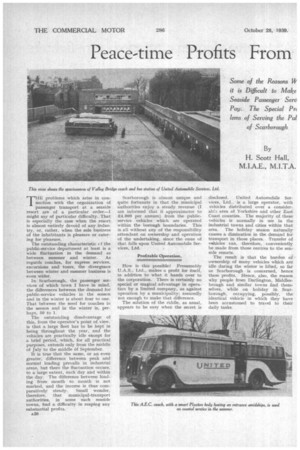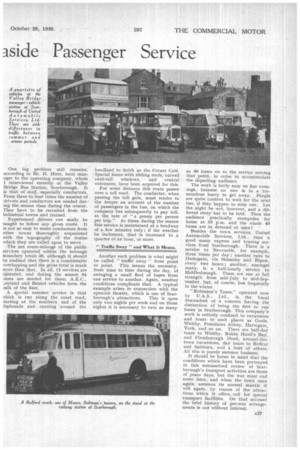Peace-time Profits From aside Passenger Service
Page 36

Page 37

If you've noticed an error in this article please click here to report it so we can fix it.
Some of the Reasons f4/ it is Difficult to Make Seaside Passenger Serv Pay. The Special Pr( lems of Serving the Put!
of Scarborough
By H. Scott Hall, M.I.A.E., M.I.T.A.
THE problems which arise in connection with the organization of passenger transport at a seaside resort are of a particular order-1 might say of particular difficulty. That is especially the case when the resort is almost entirely devoid of any industry, or, rather, when the sole business of the inhabitants is pleasure or catering for pleasure.
The outstanding characteristic rf the public-service department at least is a wide fluctuation in the demand as between summer and winter, As regards coaches, for express services, excursions and tours, the divergence between winter and summer business is even wider.
In Scarborough, the passenger services of which town 1 have in mind, the differenri-. between the demand for public-service vehicles in the season and in the winter is about four to one. That between the need for coaches in the season and in the winter is, perhaps, 50. to 1.
The outstanding disadvantage of this, from the operator's point of view, ' is that a large fleet has to be kept in being throughout the year, and the vehicles are practically idle except for a brief period, which, for all practical purposes, extends only from the middle of July to the middle of September. It is true that the same, or an even greater, difference between peak and normal loading prevails in industrial areas, but there the fluctuation occurs, to a large extent, each day and within the day. The difference between loading from month to month is not marked, and the income is thus comparatively steady. Small wonder, therefore, that municipal-transport authorities, in some such seaside towns, find a difficulty in reaping any substantial profits_ A26
Scarborough is almost unique and quite fortunate in that the municipal authorities enjoy a steady revenue (I am informed that it approximates to £4,000 per annum) from the publicservice vehicles which are operated within the borough boundaries. This is all without any of the responsibility attendant on ownership and operation of the undertaking, sincethe onus of that falls upon United Automobile Services, Ltd.
Profitable Operation.
How is this possible? Presumably ILA-S., Ltd., makes a profit for itself, in addition to what it hands over to the corporation. There is certainly no special or magical advantage in operation by a limited company, as against operation by a municipality; assuredly not enough to make that difference.
The solution of the riddle, as usual, appears to be easy when the secret is disclosed. United Automobile Services, Ltd., is a large operator, with vehicles distributed over a considerabs area of Yorkshire and other East Coast counties. The majority of these vehicles is normally in use in the industrial towns and cities within that area. The holiday season naturally causes a diminution in the demand for transport in those places. Transfer of vehicles can, therefore, conveniently be made from those centres to the seaside resorts.
The result is that the burden of ownership of many vehicles which .are idle during the winter is lifted, so far as Scarborough is concerned, hence these profits. Hence, also, the reason why people from Darlington, Middlesbrough and similar towns find themselves, While on holiday in Scarborough, occupying, possibly, the identical vehicle in which they have been accustomed to travel to their daily tasks. One big problem still remains, according to Mr. H. Hirst, local Manager to the operating company," whom I interviewed recently at the Valley Bridge Bus Station, Scarborough. It is that of staff, especially conductors. From three to four times the number of drivers and conductors are needed during the season than during the winter. They have to be recruited from the industrial towns and trained.
Experienced drivers can easily be taught to follow any given route. It is not so easy to make conductors from other towns thoroughly acquainted with the topography of the routes which they are called upon to serve.
The net route-mileage of the public services operated within the borough boundary totals 30, although it should be realized that there is a considerable Dyerlapping and the gross total is much more than that. In all, 12 services are operated, and during the season 84 Duses are needed for them; A.E.C., 1.eyland and Bristol vehicles form the Julk of the fleet. • A special summer service is that xfhich is run along the coast road, tarting at the southern end of the -Zsplanade and running around the headland to finish at the Corner Café. Special buses with sliding roofs, curved cant-rail windows, and central entrances, have been acquired for this.
For some distance this route passes over a toll road. The conductor, when passing the toll gate, must render to the keeper an account of the number of passengers in the bus, on which the company has subsequently to pay toll, at the rate of "a penny per person per trip." At times during the season this service is maintained at a headway of a few minutes only ; if the weather be inclement, that is increased to a quarter of an hour, or more.
" Traffic Sway "and What It Means.
Another such problem is what might be called "traffic sway" from point to point. This means the necessity, from time to time during the day, of swinging a small fleet of buses from one service to another. Again, weather conditions complicate that. A typical example arises in connection with the open-air theatre, which is one of Scar
borough's attractions. This is open only two nights per week and on those nights it is necessary to turn as many
as 40 buses on to the service serving that point, in order to accommodate the departing audience.
The work is fairly easy on fine evenings, because no one is in a tremendous hurry to get away. People are quite content to wait for the next bus, if they happen to miss one. Let the night be wet, however, and a different storyhas to be told. Then the audience practically stampedes for home at 10 p.m. and the whole 40 buses are in demand at once!
Besides the town services, United Automobile Services, Ltd., runs a good many express and touring services from Scarborough. There is a service to Newcastle, for example, three times per day ; another runs to Harrogate, via Helmsley and Ripon, every two hours ; another, amongst many, is a half-hourly service to Middlesbrough. These are run at lull strength from mid-July to mid-September, but, of course, less frequently in the winter.
'Robinson's Tours," operated now by U.A.S., Ltd., is. the lineal descendent of a concern having the distinction of being the first to run buses in Scarborough. This company's work is entirely confined to excursions and tours to such places as Goole, Whitby, Fountains Abbey, Harrogate, York, and so on. There are half-day tours to Whitby, Robin Hood's Bay, and Flamborough Head, around-thetown excursions, day tours to Redcar and Saltburn, and a host of others. All this is purely summer business.
It should be borne in mind that the conditions which have been portrayed in this summarized review of Scarborough's transport activities are those of peace days, but the war must end some time, and when the town once again assumes its normal mantle it will again, by reason of the attractions which it offers, call for special transport facilities, On that account the brief history of pre-war arrangements is not without interest.






























































